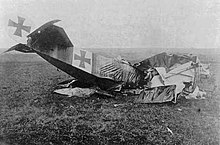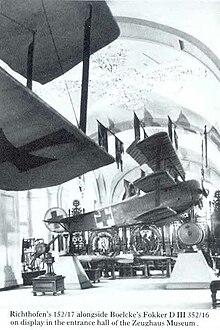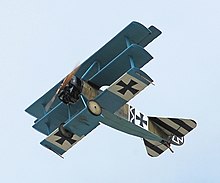German Tri Wing Plane Drawing
| Fokker DocI | |
|---|---|
 | |
| Fokker DR1 Replica | |
| Function | Fighter |
| Manufacturer | Fokker-Flugzeugwerke |
| Designer | Reinhold Platz |
| First flight | July 5, 1917 (1917-07-05) |
| Primary user | |
| Number built | 320[ane] |
| Developed from | Fokker Five.4 Fokker F.I |
| Variants | Fokker V.seven |
The Fokker Dr.I ( Dreidecker, "triplane" in High german), oftentimes known but as the Fokker Triplane, was a World War I fighter aircraft built by Fokker-Flugzeugwerke. The MedicoI saw widespread service in the spring of 1918. Information technology became famous as the aircraft in which Manfred von Richthofen gained his concluding 19 victories, and in which he was killed on 21 April 1918.
Design and development [edit]

In Feb 1917, the Sopwith Triplane began to announced over the Western Front.[ii] Despite its unmarried Vickers machine gun armament, the Sopwith swiftly proved itself superior to the more heavily armed Albatros fighters and then in use by the Luftstreitkräfte.[three] [4] In April 1917, Anthony Fokker viewed a captured Sopwith Triplane while visiting Jasta eleven. Upon his render to the Schwerin manufactory, Fokker instructed Reinhold Platz to build a triplane, simply gave him no farther information about the Sopwith design.[5] Platz responded with the 5.four, a small, rotary-powered triplane with a steel tube fuselage and thick cantilever wings,[6] first developed during Fokker'due south government-mandated collaboration with Hugo Junkers. Initial tests revealed that the V.4 had unacceptably high control forces resulting from the use of unbalanced ailerons and elevators.[7]
Instead of submitting the 5.4 for a type test, Fokker produced a revised image designated V.5. The most notable changes were the introduction of horn-balanced ailerons and elevators, besides as longer-span wings. The 5.v also featured interplane struts, which were not necessary from a structural standpoint, merely which minimized wing flexing.[8] On 14 July 1917, Idflieg issued an gild for 20 pre-product aircraft. The V.5 prototype, serial 101/17, was tested to destruction at Adlershof on eleven August 1917.[9]
Operational history [edit]


The first two pre-production triplanes were designated F.I, in accord with Idflieg's early form prefix for triplanes. These aircraft, serials 102/17 and 103/17, were the just machines to receive the F.I designation[10] and could be distinguished from subsequent aircraft past a slight convex bend of the tailplane's leading border. The two aircraft were sent to Jastas ten and 11 for combat evaluation, arriving at Markebeeke, Belgium on 28 August 1917.
Richthofen first flew 102/17 on one September 1917 and shot down two enemy aircraft in the adjacent two days. He reported to the Kogenluft (Kommandierender General der Luftstreitkräfte) that the F.I was superior to the Sopwith Triplane.[eleven] Richthofen recommended that fighter squadrons be reequipped with the new aircraft as presently as possible.[11] The gainsay evaluation came to an abrupt decision when Oberleutnant Kurt Wolff, Staffelführer of Jasta 11, was shot downward in 102/17 on 15 September, and Leutnant Werner Voss, Staffelführer of Jasta 10, was killed in 103/17 on 23 September.
The remaining pre-production shipping, designated Dr.I, were delivered to Jasta eleven.[12] Idflieg issued a production club for 100 triplanes in September, followed by an order for 200 in Nov.[13] Autonomously from the straight leading edge of the tailplane, these shipping were most identical to the F.I. The primary distinguishing characteristic was the addition of wingtip skids, which proved necessary considering the shipping was catchy to country and prone to ground looping.[14] In Oct, Fokker began delivering the PhysicianI to squadrons within Richthofen's Jagdgeschwader I.
Compared with the Albatros and Pfalz fighters, the MedicoI offered exceptional maneuverability. Though the ailerons were not very effective, the rudder and elevator controls were light and powerful.[fifteen] Rapid turns, especially to the right, were facilitated by the triplane'south marked directional instability.[fifteen] Vizefeldwebel Franz Hemer of Jasta half-dozen said, "The triplane was my favorite fighting machine because it had such wonderful flying qualities. I could allow myself stunt – looping and rolling – and could avoid an enemy by diving with perfect safe. The triplane had to be given upwardly because although it was very maneuverable, information technology was no longer fast plenty."[xvi]

As Hemer noted, the Dr.I was considerably slower than gimmicky Allied fighters in level flying and in a swoop. While initial charge per unit of climb was first-class, operation roughshod off dramatically at college altitudes because of the depression compression of the Oberursel Ur.Ii, a clone of the Le Rhône 9J rotary engine.[17] As the war continued, chronic shortages of castor oil fabricated rotary operation increasingly difficult. The poor quality of High german ersatz lubricant resulted in many engine failures, particularly during the summer of 1918.[18]
The Dr.I suffered other deficiencies. The pilot's view was poor during takeoff and landing.[nineteen] The cockpit was cramped and furnished with materials of junior quality.[twenty] Furthermore, the proximity of the gun butts to the cockpit, combined with inadequate crash padding, left the pilot vulnerable to serious head injury in the event of a crash landing.[21]
Fly failures [edit]

Heinrich Gontermann'due south wrecked Dr.I
On 29 October 1917, Leutnant der Reserve Heinrich Gontermann, Staffelführer of Jasta 15, was performing aerobatics when his triplane broke up.[22] Gontermann was killed in the ensuing crash landing. Leutnant der Reserve Günther Pastor of Jasta 11 was killed two days subsequently when his triplane broke up in level flight.[22] Inspection of the wrecked aircraft showed that the wings had been poorly synthetic. Examination of other high-time triplanes confirmed these findings. On 2 Nov, Idflieg grounded all remaining triplanes pending an enquiry. Idflieg convened a Sturzkommission (crash commission) which concluded that poor construction and lack of waterproofing had immune moisture to damage the wing structure.[23] This caused the wing ribs to disintegrate and the ailerons to break away in flying.[23]
In response to the crash investigation, Fokker was forced to ameliorate quality control on the production line, particularly varnishing of the wing spars and ribs, to combat moisture. Fokker also strengthened the rib structures and the attachment of the auxiliary spars to the ribs.[24] Existing triplanes were repaired and modified at Fokker'due south expense.[25] After testing a modified wing at Adlershof, Idflieg authorized the triplane's render to service on 28 November 1917.[26] Product resumed in early December. Past Jan 1918, Jastas 6 and 11 were fully equipped with the triplane. Only xiv squadrons used the MdI as their principal equipment. Near of these units were part of Jagdgeschwadern I, II, or III.[27] Frontline inventory peaked in late April 1918, with 171 shipping in service on the Western Front.[13]
Despite cosmetic measures, the Dr.I connected to suffer from wing failures. On 3 February 1918, Leutnant Hans Joachim Wolff of Jasta 11 successfully landed after suffering a failure of the upper wing leading edge and ribs.[28] On eighteen March 1918, Lothar von Richthofen, Staffelführer of Jasta 11, suffered a failure of the upper fly leading edge during combat with Sopwith Camels of No. 73 Squadron and Bristol F.2Bs of No. 62 Squadron.[29] Richthofen was seriously injured in the ensuing crash landing.
Postwar research revealed that poor workmanship was non the only cause of the triplane's structural failures. In 1929, National Advisory Committee for Aeronautics (NACA) investigations establish that the upper wing carried a higher lift coefficient than the lower wing – at loftier speeds it could be 2.55 times as much.
The triplane'southward chronic structural problems destroyed any prospect of large-scale orders.[30] Production somewhen ended in May 1918, by which time only 320 had been manufactured.[31] The Dr.I was withdrawn from frontline service as the Fokker D.Seven entered widespread service in June and July. Jasta 19 was the terminal squadron to be fully equipped with the MedicoI.[32]
Surviving triplanes were distributed to preparation and home defense units. Several grooming shipping were reengined with the 75 kW (100 hp) Goebel Goe.2.[33] At the time of the Armistice, many remaining triplanes were assigned to fighter training schools at Nivelles, Kingdom of belgium, and Valenciennes, French republic.[34] Allied pilots tested several of these triplanes and found their handling qualities to exist impressive.[34]

One of Richthofen's Fokker Dr.Is, on display at the Zeughaus
Experimental engines [edit]
Several MdIs were used as testbeds for experimental engines. One aircraft, designated Five.7, was fitted with the Siemens-Halske Sh.III bi-rotary engine.[35] The 5.7 exhibited exceptional rate of climb and ceiling, simply it proved difficult to handle.[35] Serial 108/17 was used to test the 118 kW (160 hp) Goebel Goe. III, while serial 469/17 was used to test the 108 kW (145 hp) Oberursel Ur. III.[36] None of these engines were used on production shipping. 1 triplane was used as a testbed for an experimental Schwade gear-driven supercharger.
Postwar [edit]
3 triplanes are known to have survived the Ceasefire. Serial 528/17 was retained as a testbed past the Deutschen Versuchsanstalt für Luftfahrt (German Aviation Research Institute) at Adlershof. After beingness used in the filming of ii movies, 528/17 is believed to have crashed sometime in the tardily 1930s.[37] Series 152/17, in which Manfred von Richthofen obtained three victories, was displayed at the Zeughaus museum in Berlin.[37] This aircraft was destroyed in an Allied bombing raid during World War II.
In 1932, Fokker assembled a Dr.I from existing components. It was displayed in the Deutsche Luftfahrt-Sammlung in Berlin. In 1943, the aircraft was destroyed in an Allied bombing raid. Today, only a few original DocI artifacts survive in museums.
Replica and reproduction aircraft [edit]


Bitz congenital Fokker Mdane replica EI-APW Lynn Garrison drove, Ireland

Large numbers of replica and reproduction aircraft have been built for both individuals and museums. Bitz Flugzeugbau GmbH congenital two Dr.I replicas, serial numbers 001 and 002, for use in Twentieth Century Fox's 1966 moving-picture show The Blue Max. Replica 001 EI-APW is the oldest surviving example of the Medicoi. Because of the expense and scarcity of accurate rotary engines, most airworthy replicas are powered by a Warner Scarab or Continental R-670 radial engine.[38] A few, withal, characteristic vintage Le Rhône 9J[39] or reproduction Oberursel Ur.II rotary engines.[40]
Variants [edit]
- V.4 – Initial prototype
- V.5 – Outset product epitome
- 5.6 – Enlarged prototype with Mercedes D.2 engine
- 5.7 – Paradigm with Siemens-Halske Sh.Iii engine
- Vagel Grip SP.5 Greif - High german mail-war 2 seat re-create of the DocI
Operators [edit]
-
 German Empire
German Empire
- Luftstreitkräfte
Specifications (Dr.I) [edit]

Official Baubeschreibung cartoon
Data from Quest for Functioning. [41]
Full general characteristics
- Crew: i
- Length: 5.77 yard (18 ft 11 in)
- Upper wingspan: seven.19 thousand (23 ft 7 in)
- Height: ii.95 m (9 ft 8 in)
- Fly area: eighteen.seven m2 (201 sq ft)
- Aspect ratio: 4.04
- Empty weight: 406 kg (895 lb)
- Gross weight: 586 kg (1,291 lb)
- Powerplant: one × Oberursel Ur.II ix-cylinder air-cooled rotary piston engine, 82 kW (110 hp)
- Propellers: two-bladed stock-still-pitch wooden propeller
Functioning
- Maximum speed: 180 km/h (110 mph, 97 kn) at 2600m
- Stall speed: 72 km/h (45 mph, 39 kn)
- Range: 300 km (190 mi, 160 nmi)
- Service ceiling: 6,100 one thousand (20,000 ft)
- Charge per unit of climb: 5.seven yard/southward (1,120 ft/min)
- Lift-to-drag: 8:1
- Fly loading: 31.0 kg/m2 (6.3 lb/sq ft)
- Zero-elevator drag coefficient: 0.0323
- Frontal area at zero-elevator drag coefficient: 0.62 grandtwo (6.seven sq ft)
Armament
- Guns: two × vii.92 mm (0.312 in) Maschinengewehr 08 "Spandau" car guns
Encounter also [edit]
- Airdrome Fokker DR-1, homebuilt replica
- Redfern Fokker Medicoi, homebuilt replica
- Sands Fokker Dr.1 Triplane, homebuilt replica
Aircraft of comparable role, configuration, and era
- Sopwith Camel
- Sopwith Triplane
Notes [edit]
- ^ Rimell, 1996, pp.1 & 21
- ^ Franks 2004, p. 9.
- ^ Franks 2004, p. 21.
- ^ Leaman 2003, pp. 30, 32.
- ^ Weyl 1965, p.223.
- ^ Leaman 2003, p. 34.
- ^ Weyl 1965, p. 226.
- ^ Weyl 1965, p. 228.
- ^ Weyl 1965, p. 229.
- ^ Weyl 1965, p. 231.
- ^ a b Weyl 1965, p. 232.
- ^ Leaman 2003, p. 53.
- ^ a b Franks and VanWyngarden 2001, p. 22.
- ^ Leaman 2003, p. 96.
- ^ a b Leaman 2003, p. 95.
- ^ VanWyngarden 2004, p. 75.
- ^ Nowarra 1990, p. 12.
- ^ Franks and VanWyngarden 2001, p. 83.
- ^ Weyl 1965, p. 245.
- ^ Weyl 1965, pp. 244–245.
- ^ Weyl 1965, p. 410.
- ^ a b Weyl 1965, p. 233.
- ^ a b Weyl 1965, pp. 233–234.
- ^ Weyl 1965, pp. 236, 239.
- ^ Weyl 1965, p. 235.
- ^ Weyl 1965, pp. 238–239.
- ^ Franks and VanWyngarden 2001, p. 55.
- ^ Franks and VanWyngarden 2001, p. 25.
- ^ Franks and VanWyngarden 2001, pp. 26–27.
- ^ Weyl 1965, p. 236.
- ^ Greyness and Thetford 1962, p. 100.
- ^ Leaman 2003, p. 69.
- ^ Leaman 2003, p. 222.
- ^ a b Weyl 1965, p. 246.
- ^ a b Weyl 1965, p. 248.
- ^ Weyl 1965, pp. 249–250.
- ^ a b Leaman 2003, p. 181.
- ^ Nowarra 1990, p. 47.
- ^ "Cole Palen's Old Rhinebeck Aerodrome — Fokker Physicianone Triplane". oldrhinebeck.org. Quondam Rhinebeck Drome. Retrieved May 12, 2021.
- ^ "Oberursel UR.2" The Vintage Aviator. Retrieved: 6 Nov 2016.
- ^ Loftin 2004, Tabular array I.
References [edit]
- Franks, Norman. Sopwith Triplane Aces of Earth War I (Aircraft of the Aces No. 62). Oxford: Osprey Publishing, 2004. ISBN 1-84176-728-10.
- Franks, Norman and Greg VanWyngarden. Fokker Dr.I Aces of Globe War I (Aircraft of The Aces No. 40). Oxford: Osprey Publishing, 2001. ISBN one-84176-223-7.
- Gray, Peter and Owen Thetford. High german Aircraft of the First Globe State of war. London: Putnam, 1962. ISBN 0-933852-71-1
- Imrie, Alex (1978-07-15). High german Fighter Units June 1917 - 1918. London: Osprey Publishing Express, 1978. ISBN0-85045-289-9.
- Imrie, Alex. Fokker Fighters Of World War Ane. London: Arms and Armour Printing, 1986. ISBN0-85368-782-X.
- Imrie, Alex. The Fokker Triplane. Artillery and Armour Press, 1992. ISBN one-85409-118-two.
- Leaman, Paul. Fokker Dr.I Triplane: A World State of war 1 Legend. Hersham, Surrey, Britain: Classic Publications, 2003. ISBN one-903223-28-8.
- Loftin Jr., Laurence K. Quest for Operation: The Evolution of Mod Aircraft. NASA Scientific and Technical Information Branch, 2004. Retrieved on 22 Apr 2006.
- Nowarra, Heinz J. Fokker Dr.I In Action (Shipping No. 98). Carrollton, TX: Squadron/Signal Publications, Inc., 1990. ISBN 0-89747-229-2.
- Rimell, Raymond Laurence (1996). Fokker Triplane. Windsock Datafiles 5. Herts, United kingdom of great britain and northern ireland: Albatros Productions. ISBN978-0948414039.
- VanWyngarden, Greg. Richthofen'southward Flight Circus: Jagdgeschwader Nr I (Aviation Elite Units No. 16). Oxford: Osprey Publishing, 2004. ISBN 1-84176-726-three.
- Weyl, A.R. Fokker: The Creative Years. London: Putnam, 1965. ISBN 0-85177-817-8.
External links [edit]
| | Wikimedia Commons has media related to Fokker Dr1. |
- Fokker DR1.com – Enquiry on the Fokker MdI
- Fokker MedicoI Triplane: Germany
- Fokker Dr. I – National Museum of the United States Air Strength
- Cole Palen's rotary powered Dr.I reproduction (US registration N3221) at Old Rhinebeck Aerodrome
cornejothenstuthe.blogspot.com
Source: https://en.wikipedia.org/wiki/Fokker_Dr.I
0 Response to "German Tri Wing Plane Drawing"
Postar um comentário